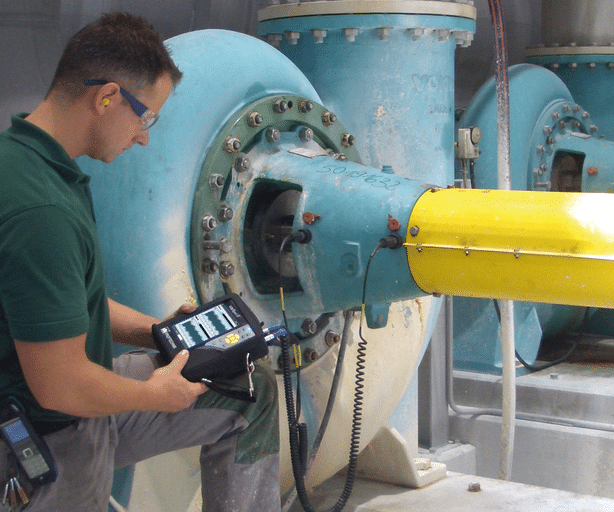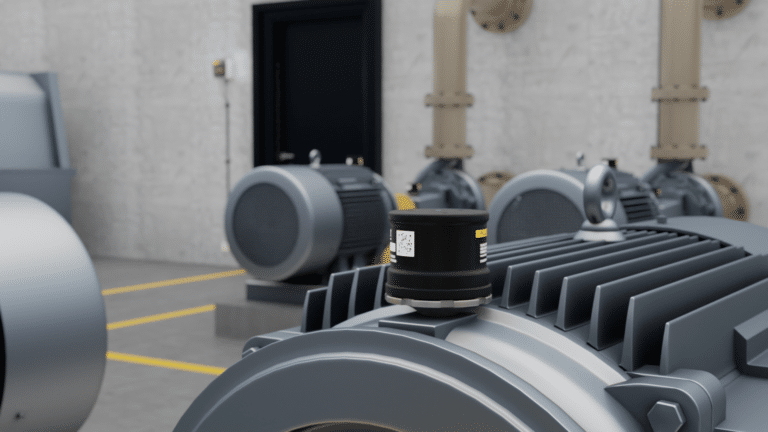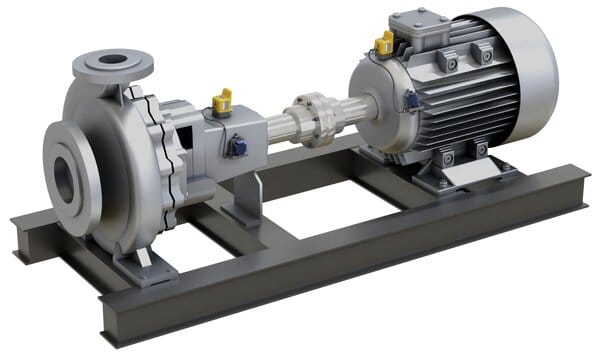
Establishing a vibration analysis program is a marathon, not a sprint. So, before you jump to buying a handheld vibration analyzer, it’s important to first step back and consider your overall vibration program goals and the kind of tool that can help achieve them. What problems does your maintenance team need to solve? Are you actually trying to find the root cause of emerging machine problems or just screen for overall vibration? What is the true lifetime cost you’re willing to pay for the solutions you’re considering?
One of the first things most people learn about vibration monitoring is that it can be effective for spotting indications of the four most common machine faults: imbalance, misalignment, looseness, and bearing wear. However, the reality is that many tools will struggle to find those faults, making it more difficult to take action on the data.
Comparing Handheld Vibration Analyzers
Today, many vibration analyzers on the market simply provide an overall vibration value. This single value is used to indicate the overall health of a machine. As you might expect, trending overall values this way can be misleading. For example, bearing faults occur at high frequencies, and an overall value reading on a basic handheld vibration analyzer may not change much prior to a bearing failure. This kind of vibration analysis is useful for its simplicity, and it can be valuable for screening assets, but it has clear limitations.
A small change in a high frequency may only slightly move your overall velocity and inches per second readings. Your vibration analyzer could suggest everything’s fine, when in fact you have a major problem forming in the machine.
Overall vibration can’t identify the root cause of vibration. It also doesn’t account for the fact that different machines have differing levels of acceptable overall vibration. And it overlooks the fact that some faults won’t impact the overall vibration value until after the damage has already occurred.
READ MORE: How Vibration Analysis Extends Asset Lifespan and Prevents Failure
By using a more powerful handheld vibration analyzer like the VibXpert II — a spectrum analyzer — you can perform a Fast Fourier Transform (FFT). A spectrum analyzer is a tool that measures and displays an input signal, like vibration amplitude, and then shows how its strength varies across a frequency range. This makes it possible to take the waveform, break it down into specific frequencies, and see the high-end frequencies where the changes are actually taking place.
That may sound intimidating to a beginner, but new users can be trained to use the VibXpert II for route-based measurements, then have more seasoned team members — or expert service providers like Fluke Reliability — analyze the data later on.

Key Differentiators with the VibXpert II
- VibXpert II is a powerful handheld vibration analyzer that can identify specific faults.
- It works non-intrusively during routes from outside a machine – even while the machine is still running.
- VibXpert II can monitor standard, constant-speed, and variable-speed machines.
- There are no recurring fees. The up-front price reflects true cost of ownership. Other handheld vibration analyzers require support agreements that can double the cost of ownership.
The VibXpert II is an advanced handheld vibration analysis tool capable of identifying specific faults. As a spectrum analyzer, it’s much more powerful than the overall vibration products on the market today. The difference between an overall vibration tool and a spectrum analyzer is similar to being triaged vs. visiting a specialist.
Consider a gearbox. A spectrum analyzer like the VibXpert II from Fluke Reliability can pick up anomalies in gear mesh frequencies. As a result, you can see cracked teeth. Additionally, you can watch the gears and see if there’s anything wrong with the transfer of power from the machine through the gearbox. If there are anomalies, it’s possible to identify where they are.
It is a handheld device used at the machine itself, whether that’s in clinically clean systems or harsh industrial environments. The VibXpert II takes reliable and efficient measurements and pairs with the included OmniTrend software for precise results and simple reporting. The Automatic Switchbox feature of the VibXpert II even eliminates a common form of human error during data collection.
The VibXpert II works on both standard, constant-speed machines that run at specific RPMs, as well as on variable-speed machines, where the speed change is based on load. In addition, the VibXpert II does this non-intrusively — that is, from the outside of the machine while the machine is still running. That’s key for catching problems and also avoiding production interruptions, which saves time and money.
The OmniTrend software is powerful but simple to use. The software is designed to be user-friendly for roles throughout a maintenance team, from the technicians taking the measurements to the leadership generating or reading reports. As a result, your team can avoid pencil whipping — people marking maintenance as completed when in fact is hasn’t been — which creates gaps in maintenance operations that increase the risks of safety hazards, equipment damage, inventory issues, and more. Speeding up and simplifying data collection, analysis, and reporting reduces the likelihood of pencil whipping.

Lower Total Cost of Vibration Analyzer Ownership
Advanced products such as the VibXpert II can cost more upfront than entry-level models. But once you purchase the VibXpert II, the only ongoing cost is the calibration every two years on the instrument itself.
With the VibXpert II, you pay upfront for the true cost of ownership over a 10-year period. That’s it. Other handheld vibration analyzers on the market make your company purchase support agreements. This annual cost traditionally runs about 13% of the cost of the instrument. That means your team has to pay another 130% of what you paid upfront on that competitor’s device over the same 10-year period. That’s more than double the true cost of ownership of the VibXpert II.
Other products also limit or charge for data points — that is, they limit the number of machines you can have in your database. Depending on the product, that limit is either a hard cap and you cannot add any points at all or you can — but you’ll be charged for adding additional machines to the database.
With the VibXpert II, you can do 100 points or 1,000 points, or whatever your specifications are. It’s unlimited. Once you own the VibXpert II, you own it, and you can use it as much as you need. A customer who wanted to ensure that a certain bearing wouldn’t fail before a production run was complete even used the VibXpert II twice a day to check the same machine. You can go to any piece of equipment at any time to collect data.
The VibXpert II also unlocks a huge range of capabilities many other tools can’t touch. With the VibXpert II, you can build a machine database of your plant, then collect and interrogate individual points on each machine and identify specific faults. When you have historical data for each machine in your facility, you can easily identify anomalies and determine what the fault is — and solve it — before it leads to damage or downtime. An overall vibration tool cannot match that.
Reducing Reactive Maintenance Costs
Downtime is one of the biggest problems that maintenance teams face, and it’s often why they look at starting a vibration program. A large part of the potential ROI with the VibXpert II comes from eliminating unforeseen downtime. If you know what piece of equipment’s failing, then you can put your maintenance resources on that problem before it stops production. You can have your planning staff get bearings ready if it’s a bearing going bad, or if they need to replace a gearbox.
One VibXpert II customer formerly ran their machines to failure. They lost two compressors within a year because of bearing damage. Liquids were seeping in and the chemicals used to clean pipes created heat. When the liquid-cooled, it hardened and created an imbalance. After a change in leadership, there was a cultural shift from reactive maintenance to predictive maintenance — and now they are fixing problems rather than replacing machines thanks to the VibXpert II.
Reducing or even eliminating reactive maintenance is a huge cost savings. For a number of reasons, reactive maintenance costs can run about three times higher than planned maintenance. Ordering expedited parts is costly, but with the continuing supply chain problems many industries are experiencing, the part you need may not be available when you need it — even if you’re willing to pay a premium. If it takes a week to get the needed parts for a machine, that could mean production is completely down until that machine is back online. On top of that, overtime racks up quickly when you have to call people in on nights or weekends.
Like taking a last-minute flight, anytime you’re doing something when you hadn’t planned for it, it’s going to cost more.

Final Consideration
Ultimately, the important thing to realize is that there’s a culture change that has to take place in your company itself when you start a vibration program. That’s because some types of measurement, such as alignment, are more like instant gratification. But if you’re not already doing any vibration analysis at all, it will require some time and training.
When it comes to vibration analysis, the real power is not in a spot check, it’s in a long-term establishment of data where you can compare month to month, or quarter to quarter, how a machine is performing. And you can lay that data over a period of time — called a waterfall — and actually see how a machine is changing.
The VibXpert II can set your team on a path to success with that journey, and it can do so at a lower lifetime cost of ownership than most other handheld vibration analyzers that boast similar capabilities.






